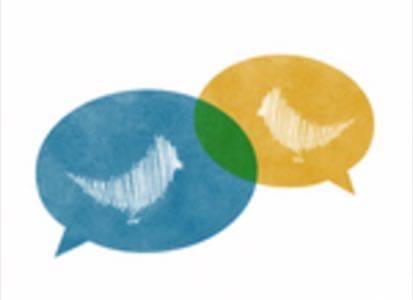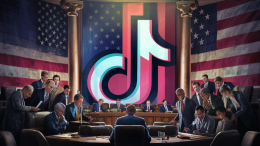When Twitter first launched in 2006, there was no handbook published about who should use it and how. As the service’s user base grew, best practices were established organically and conventions like retweeting and hash tags were created by the community. Today, the platform is used for a wide range of purposes, from suburban teens gossiping amongst each other to movie stars broadcasting their thoughts to a massive following and engaging fans in conversation.

Over time, a number of use cases have emerged for which Twitter has proven to be particularly effective. Its role in augmenting the TV-watching experience is one the company has embraced officially. So is the way Twitter is used in gathering and disseminating news.
The latest group of Twitter users to get an official nod from the company is musicians. Last week, a set of guidelines titled Twitter For Musicians and Artists was published on the Twitter Developers site. The guide draws from a few notable examples of artists who have leveraged the platform effectively and offers a few pointers for bands and musicians looking to do the same.
It might seem surprising to those of us who use Twitter constantly, but people who make and record music for a living may or may not have a knack for – or much of an interest in – managing social media accounts. Many just want to play music. Yet for musicians today, especially smaller, independent artists, not taking full advantage of the social Web is an huge missed opportunity, presuming one wants their work to be heard by as many people as possible.

Some bigger acts will have access to resources robust enough to allow them to outsource Twitter management if they prefer, but most bands and musicians don’t have that luxury.
Even if they do, many would argue that tweeting in one’s own voice is a more authentic, effective way to converse with fans and other artists. That being the case, this Twitter stuff is pretty much unavoidable for any band or solo artist who wants to maximize their chances of having a successful career in the music industry.
“I think you lose a lot if you outsource your social communication to third parties,” says Mike More, CEO of Headliner.fm, a social marketing platform for musicians. “It only takes a few minutes a day. There’s a very big upside for artists that invest their time in getting it right.”
For Artists, Twitter is a Direct Line to Fans
The biggest and most obvious advantage of using Twitter for artists is the ability it offers them to engage directly with fans. This is something Amanda Palmer has become quite well-known for among those that follow her. The Boston-based musician and member of The Dresden Dolls is described as a “Twitter ninja” on Twitter’s official guide for musicians and is generally recognized as one of more active and engaging musicians using the service.
Not only does Palmer chats back and forth with fans but she eagerly seeks their input on things like songwriting and t-shirt design.
“One of the main advantages Twitter has for artists is that it’s more open than Facebook or any other social platform,” says More. “Artists can follow any band they’re into and connect with them easily. This is a big plus.”
This lends itself to the possibility of connecting with like-minded artists and if one possesses the right blend of luck and relevance, getting followed or retweeted by a band with a massive following.
But it also makes that artist-to-fan communication much easier than it ever was before, and different artists utilize it in different ways. Some are impersonal and almost broadcast-esque, while others choose to get a little more intimate.
One night, Flaming Lips frontman Wayne Coyne was driving down a long stretch of road listening to the band’s latest recording when he heard a thud.
“Fuck!!!! I was driving around listening to our new mixes … it is one of the great pleasures of creating your own music..and out of nowhere this opossum runs out in front of the van…!!” Coyne explained over course of three consecutive tweets. “I tried to miss it but was goin bout 50… thuoght I missed it but then heard and Felt that awful thud …drove back just to make sure.. you can see it …I feel horrible..All life is precious..”
As he turned around and retraced his path to check out the dead possum, Coyne recorded a brief video on his iPhone of the animal’s corpse laying on the dimly-lit road, with the band’s latest demo serving as the soundtrack.
It might sound like a weird example, but it’s one that fits right in with the overall image given off by The Flaming Lips, who are known for their psychedelic live shows and highly experimental, often bizarre projects. Those who follow Coyne on Twitter are accustomed to seeing strange videos, tasteful photos of Coyne’s barely-clothed wife and off-the-cuff remarks about whatever the band is doing at that moment, from pressing vinyl to rehearsing new material.
Other artists have opted to stay relatively silent. Philadelphia singer-songwriter Kurt Vile started a Twitter account last year, but only used it to briefly defend his decision to to allow a song of his to be used in a Bank of America commercial. Beyond that, Vile hasn’t used Twitter for any other purpose. As a result, fans who @mention his username are not getting a response. By contrast, Roots drummer Questlove, another Philly artist, actively uses Twitter to share links, comment on politics and converse with some of his nearly 2 million followers.
For fans, the value in all of this is quite substantial. Never before have people had such easy access to everything from unreleased material and promotional offerings to the unfiltered – sometimes rather personal – thoughts of the artists they admire. All of this comes at them in real-time and is limited only by what a given artist feels compelled to share. This has a the effect of building the artist’s brand, but the value is far from being a one-way street. People eat this stuff up.
Sounds Cool, But Where’s the Value?
Everybody says social media is important, but does putting in the effort actually pay off? It depends on what one’s definition of “value” is and, of course, on who the artist is and what they’re approach to social networking happens to be.
As with most forms of social marketing, the primary value here is in building up one’s brand and establishing a line of communication with customers – in this case, music fans. It may not lead immediately to an increase in record sales or concert attendees, but the act of cultivating those relationships over time will probably increase the likelihood of fans coming out to show or buying a record.
Asking Twitter followers to buy one’s latest album is probably not a good approach, warns More. “That doesn’t provide any value for your fans. It’s a demand.” Instead, the experts recommend having conversations with fans, soliciting their feedback when appropriate and doing things like host group interviews via Twitter. When the opportunity arises for fans to enter their credit card information, those that want to will do it.
Amanda Palmer experienced this firsthand when she used Twitter to sell a t-shirt whose design was influenced by the feedback of her followers. In the first two hours, the shirt brought in $11,000, according to Twitter.
Similar results have been seen by other artists, whether they’re selling a new record or using Twitter to get rid of the last few remaining tickets to an upcoming show.
Of course, results vary depending on who the act is and how big they are. Independent, local bands are going to have a hard time breaking a few hundred followers until they’ve amassed an a legitimate, real-world fan base.
That’s a point very much worth noting. As powerful as tools like Twitter and Facebook can be in any industry, they are no substitute for human, real-world connections made at live performances or by networking with other bands and industry players. Like in other areas, social networking via the Web is complementary to those human connections. It just happens to be one with incredible potential.










